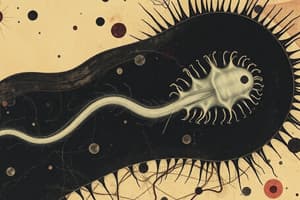Podcast
Questions and Answers
Which characteristic best describes the cyst stage of Entamoeba histolytica?
Which characteristic best describes the cyst stage of Entamoeba histolytica?
- It is the actively feeding and reproducing form.
- It is resistant to environmental conditions and infective. (correct)
- It primarily causes intestinal symptoms upon ingestion.
- It requires optimal environmental conditions to survive.
What is the primary method for diagnosing intestinal amebiasis?
What is the primary method for diagnosing intestinal amebiasis?
- Radiological imaging of the abdomen.
- Stool examination using trichrome stain. (correct)
- Liver function tests.
- Direct PCR of intestinal biopsy.
Which statement about the clinical manifestations of Entamoeba histolytica is correct?
Which statement about the clinical manifestations of Entamoeba histolytica is correct?
- All infections present with bloody diarrhea.
- Amebic dysentery is characterized only by abdominal pain.
- Abdominal flatulence is a hallmark of intestinal amebiasis.
- Liver abscess is the most common extraintestinal complication. (correct)
What role do lectins play in the pathogenesis of Entamoeba histolytica?
What role do lectins play in the pathogenesis of Entamoeba histolytica?
Which method is effective in preventing infection by Entamoeba histolytica?
Which method is effective in preventing infection by Entamoeba histolytica?
Flashcards
Entamoeba histolytica
Entamoeba histolytica
A protozoan parasite causing amebiasis, a disease primarily affecting the intestines but capable of spreading to other organs.
Transmission of Entamoeba histolytica
Transmission of Entamoeba histolytica
Fecal-oral transmission. Ingested mature cysts develop into trophozoites, causing infection.
Trophozoite
Trophozoite
The active, feeding form of Entamoeba histolytica.
Cyst
Cyst
Signup and view all the flashcards
Amebic dysentery
Amebic dysentery
Signup and view all the flashcards
Liver abscess
Liver abscess
Signup and view all the flashcards
Metronidazole
Metronidazole
Signup and view all the flashcards
Stool examination
Stool examination
Signup and view all the flashcards
Sanitation
Sanitation
Signup and view all the flashcards
Personal hygiene
Personal hygiene
Signup and view all the flashcards
Study Notes
Entamoeba histolytica: Key Characteristics
- Entamoeba histolytica is a protozoan parasite.
- Transmission occurs through the fecal-oral route, via ingested cysts in contaminated food or water.
- Two primary life cycle stages exist: trophozoites (actively feeding and reproducing) and cysts (infective, resistant to environmental conditions).
Pathogenesis and Symptoms
- Entamoeba histolytica adheres to intestinal mucosa using lectins.
- It invades tissues, releasing proteolytic enzymes.
- Ulcer formation, often flask-shaped, is a characteristic feature.
- Extraintestinal spread is possible, affecting organs like the liver, lungs, and brain.
- Infection can be asymptomatic or manifest as intestinal or extraintestinal disease.
- Intestinal amebiasis can present as amebic dysentery (bloody diarrhea, abdominal pain, fever) or amebic colitis (diarrhea, abdominal pain, flatulence).
- Liver abscess is the most common extraintestinal complication.
Diagnosis and Treatment
- Microscopy of stool samples (wet mount, iodine, trichrome stains) identifies trophozoites and cysts.
- Serological tests measure antibodies.
- Metronidazole targets trophozoites, and paromomycin targets cysts.
Prevention
- Proper sanitation is crucial, including sewage disposal and safe water.
- Personal hygiene through handwashing is essential.
- Thorough food preparation prevents infection.
Studying That Suits You
Use AI to generate personalized quizzes and flashcards to suit your learning preferences.





